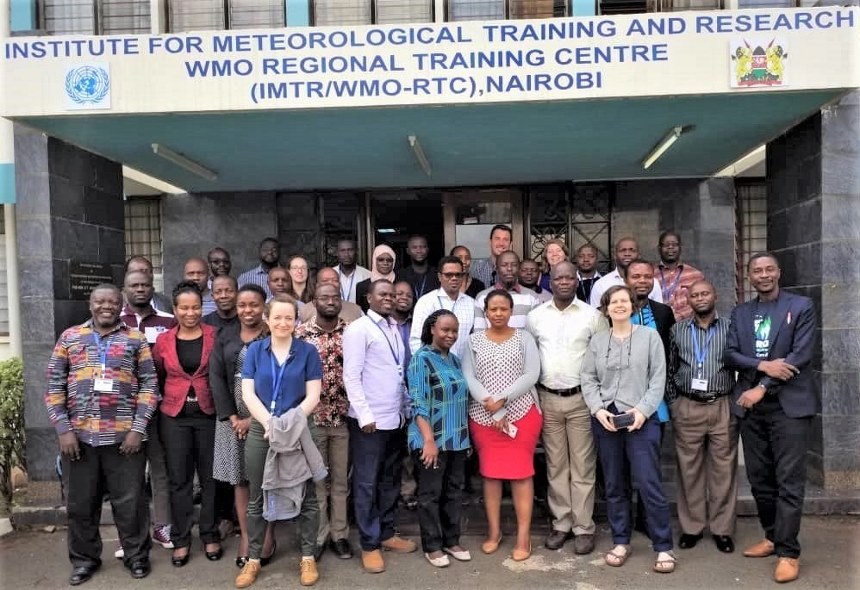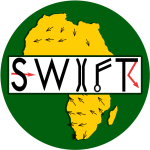By Dr Alexander Roberts, National Centre for Atmospheric Research and University of Leeds
A new study outlines the challenges in delivering short-term weather warnings in Africa, called nowcasting, and proposes ways solutions can be provided in the coming years.
A recent GCRF African SWIFT paper published in the Royal Meteorological Society Journal Weather details approaches to nowcasting, discusses the reasons that these have not been adopted in Africa and provides information on the work being undertaken by the GCRF African SWIFT project to help African national meteorological services improve their satellite-based nowcasting capabilities and enable research in African universities. This has included provision of nowcast products online, alongside work to generate these products at SWIFT centres in Africa.
Nowcasting is the practice of producing and distributing warnings of high impact weather on short time scales. In wealthy countries such as the UK and the USA, there is a history of nowcasting that spans almost 50 years. Systems used for nowcasting are generally heavily dependent on technology that is not widespread across Africa. For example rainfall radar systems are common across North America and Europe and provide near real time information on both the distribution and intensity of rainfall. This kind of information means that forecasters are able to provide warnings of extreme weather conditions that might cause extensive damage or endanger life.

In Africa extreme weather (associated with very large thunderstorm systems) is more frequent and has the potential to cause more harm due to the greater vulnerability of people, property and infrastructure. This is expected to increase with climate change, and improved warnings are needed to improve resilience. Meanwhile forecasts of rainfall from weather models often exhibit very low skill in the tropics and Africa. Without access to the same nowcast systems used in wealthier nations (due to high initial costs and difficulty maintaining systems) there comes a need to make use of alternatives such as geostationary meteorological satellites instead of ground-based rainfall radar.
Methods for performing nowcasting using meteorological satellites are not recent innovations and there has been discussion in the scientific community about the value of such techniques for decades. Despite this, uptake of nowcasting in Africa is generally limited to fairly simplistic methods and is primarily focussed on the aviation industry (South Africa being a notable exception). Barriers to the use of nowcasting in Africa include financial, infrastructure and skills gaps. These issues can make the commissioning and maintenance of systems for nowcasting very difficult.

A clear example of the issues faced by African forecasters can be understood by considering the EUMETSAT Satellite Application Facility for Nowcasting (NWC SAF) software NWCSAF/GEO. This software has been in existence (over several iterations) for over 10 years and is specifically designed for use with Meteosat Second Generation data. However, prior to the SWIFT project it was not in use in any of the SWIFT partner national meteorological services (including Senegal, Ghana, Nigeria and Kenya). In part due to the complexity of setting up such a system and difficulties accessing data from existing forecasting systems. African meteorological services have access to satellite data via the EUMETCAST service via a satellite link and Preparation for the Use of Meteosat in Africa (PUMA) computer stations.
Like other nowcasting systems, the NWCSAF/GEO software allows the user to gain greater insight into meteorological conditions than simple satellite imagery. It also provides the capability to extrapolate imagery into the future, making forecasts for the next few hours possible. Standard forecasting techniques that use numerical weather prediction models are unable to provide such information. This is partly due to the time and computing resources required to perform simulations, which means they are generally initialised on a 6 hourly basis. Simulations of this type not only require time to run but there is also spin up time (where the model stabilises and develops important structures) which means the first few hours of a simulation are often unreliable. Added to this is the fact that weather model performance in the tropics is known to be poorer than in the mid-latitudes with extreme weather being especially poorly predicted.
As such the use of satellite nowcasting systems can provide valuable information to forecasters that cannot be found from other sources. This approach is also not so complex or expensive to preclude African meteorological services in the same way as commissioning a widespread rainfall radar network. In addition to this, much of the required infrastructure, such as satellite antenna for receiving satellite imagery, is already extant within African national meteorological services.

To help introduce NWCSAF/GEO products to African users, they have been made available online by the National Centre for Atmospheric Science (NCAS). A large number of nowcasting products are produced in near real time (approximate 30-minute latency) and are subsequently kept in the online catalogue for future reference. These products have been used in a series of testbeds of which nowcasting made up one of the three major focuses (the others being synoptic meteorology and evaluation). The testbeds are a programme that bring together researchers and forecasters from Africa and the UK in real-time forecasting settings (the first of their kind in Africa, to our knowledge). The aim of these is to accelerate the operational use of tools (such as NWCSAF/GEO) and engender a sense of shared purpose across meteorological institutions in Africa and the UK.
As well as providing products online, the GCRF African SWIFT project has been working with African institutions to build capacity for the use of nowcasting tools in Africa. Training has been delivered and resources made available to assist in the setting up of satellite receiving hardware and the use of the NWCSAF/GEO nowcasting software. Several African meteorological services as well as the African Centre of Meteorological Applications for Development (ACMAD) have begun the process of setting up systems to operationally produce NWCSAF/GEO products. Additionally, four satellite antennas have been purchased for SWIFT partner universities to enable research and nowcasting training to be conducted using satellite data.
It is hoped that the nowcasting work of SWIFT can provide a roadmap for how African nowcasting can be achieved. While this is ambitious there is a great need and much potential for improvement. We recognise the risk that advances might be temporary but anticipate that the SWIFT approach of: (1) avoiding complicated or expensive infrastructure, (2) providing technical training and support and (3) encouraging the cooperation of African institutions will encourage self-sufficiency, and with it, effect long-lasting change.
Paper Information
Roberts, A., Fletcher, J. K., Groves, J., Marsham, J. H., Parker, D. J., Blyth, A. M., Adefisan, E. A., Ajayi, V. O., Barrette, R., de Coning, E., Dione, C., Diop, A. … Woodhams, B. J. (2021). Nowcasting for Africa: Advances, potential and value. Weather. https://doi.org/10.1002/wea.3936
About the Author
Dr Alexander Roberts is a post-doctoral researcher at the National Centre for Atmospheric Science. Currently he is working on nowcasting for Africa within the Global Challenges Research Fund African Science for Weather Information and Forecasting Techniques (GCRF African SWIFT) programme. Previously Alex worked on the SWAMMA project investigating the dynamics of the West African Monsoon in the Met Office Unified Model (UM). Prior to this he worked towards his PhD investigating meso-scale convective systems over West Africa close to the monsoon front.
